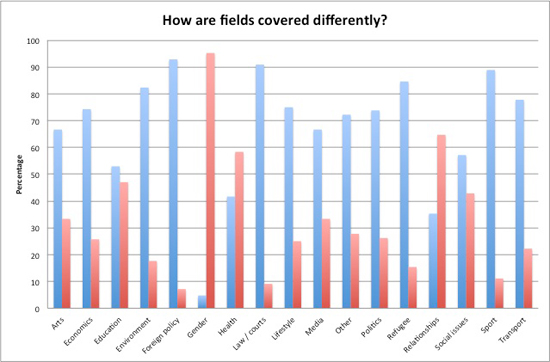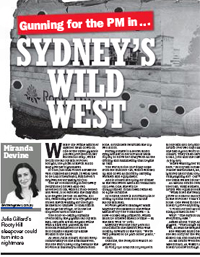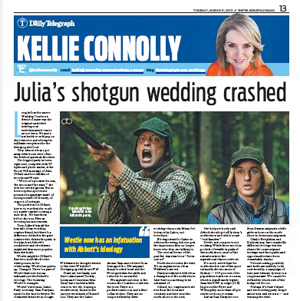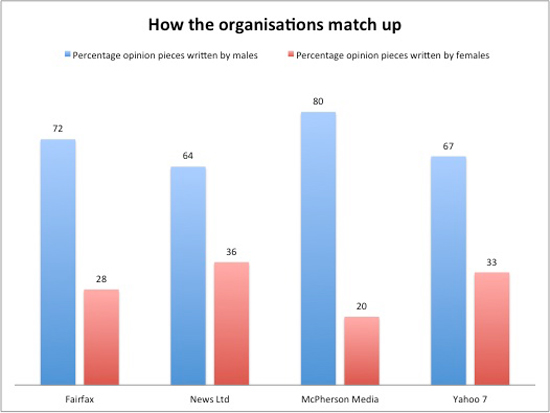In part one of “Where are the women in the media?”, we found that at the top of Australian media companies, power is highly concentrated in the hands of men — with the exception of the boards of the ABC and SBS — and that there is no woman editor of a daily mainstream print/online publication.
In part two, we present a gender analysis of opinion and commentary articles in mainstream print/online media. Commentators aim to shape policy and persuade others of their views of contemporary events. Editors shape commentary through their selection of regular columnists and their choice of opinion editors who choose pieces from staff journalists and guest opinion writers. Our analysis reveals that while strong female voices are present, men dominated across all publications and most topics.
For this analysis, we assessed 328 pieces published in 27 national, metro and major regional newspapers around the country for one week between 27 February and 5 March 2013. The week chosen overlapped with the week leading up to International Women’s Day on 8 March. Publications included national and metropolitan papers and several major regional dailies. There were 18 News Ltd papers (192 stories), seven Fairfax papers (116 stories), Shepparton News, which is owned by McPherson Media (five stories) and The West Australian owned by Seven West Media (15 stories).
While exact proportions of male versus female voices would be expected to vary from week to week, clear patterns emerge.
Key findings
- Approximately one third of opinion pieces and commentary analysed were written by women. 108 pieces published were written by women (33 per cent) and 220 were written by men (67 per cent).
- Politics was by far the most popular topic with 84 pieces, of which almost three quarters were written by men.
- Male commentary was more dominant in Fairfax than News Ltd. Of the 116 stories in Fairfax papers: 32 written by women (28 per cent) and 84 written by men (72 per cent). Of the 192 stories in News Ltd papers: 70 written by women (36 per cent) and 122 written by men (64 per cent).
- Fifteen opinion pieces were identified in The West Australian of which five were by women.
- The fields of reporting in which male voices were most dominant were law/courts/crime, foreign policy/international relations and sport.
- The only fields in which women wrote more than 50 per cent of published pieces were relationships/parenting and specifically gender focussed articles. Twenty-one pieces (6 per cent of total) were focussed on gender, 20 of which were written by women.
- Of the 21 gender focused pieces,11 were written from a pro-feminist or gender equality perspective.
- Commentary on social issues, education and health was more gender balanced.
- The most prolific opinion writers were Andrew Bolt (eight) and Jessica Irvine (eight) both of whom wrote two pieces which were syndicated across News Ltd. They were followed by News Ltd columnist Laurie Oakes with five pieces.
- Of eight opinion pieces about economics by women, six were by-lined Jessica Irvine. This included one piece which was republished across five different News Ltd papers.
- Samantha Maiden, the political editor of the Sunday Telegraph published four of 22 pieces by women about politics. She is also syndicated across News Ltd.
- Papers published at the weekend (2 and 3 March), when there are more women in senior positions and more women readers, were slightly more gender balanced in their selection of opinion writers. They published 109 opinions pieces: 69 male (63 per cent) and 40 female (37 per cent).
- Even at the weekend, News Ltd was more gender balanced than Fairfax with 43 per cent of articles by women (26) compared to only 30 per cent at Fairfax (13).
- The West Australian, owned by Seven West Media, followed the pattern of the eastern seaboard with 15 articles of which five (33 per cent) were written by women.
- Of five opinion pieces in Shepparton News, one was by a woman. (More research across regionals and rural publications could establish whether there is more gender bias in rural areas than cities.)
- Most opinion pieces are written by in-house or regular commentators of whom a majority are men. (Sixty per cent of News Ltd pieces and 51 per cent of Fairfax). There were another 20 from other parts of the media, most of whom were men.
- The biggest group of outsiders were current or past politicians or people closely associated with the Coalition (14), Labor (10) of whom only five were women. Some of these are frequent commentators. The sole Green was a woman.
- Other commentators included academics, professionals, think tanks, peak councils and a few NGOs, in each case mostly men.
The media’s preference for status favours men and reflects male domination in other spheres. Some women (and men) could find the instruction on Fairfax’s National Times opinion section, which is edited by two women, a turn-off:
“Those with experience in the topic — an experience that suggests people should take note of the opinion — are more likely to be published. You don't have to hold a university chair in the subject, but you should have some reason to justify publication.”
How did we do our analysis?
We coded all opinion pieces according to publication, date, gender of author, type of author (in-house, external, type of external), field of journalism (politics, economics, lifestyle etc). We did not analyse opinion pieces in the business or sports sections which are both very dominated by male writers. We also did not include food, fashion, property sections or other supplements. (We include sport and economics/business when pieces appeared on general commentary or opinion pages.) If pieces were syndicated we counted them each time they appeared.
Which publications?
For a list of publications surveyed, see below.
Discussion
In part one of this project we showed that men control the upper echelons of the media. Since Amanda Wilson left the editorship of the Sydney Morning Herald last year, no woman edits a daily newspaper. There are, however, at least three female editors of Saturday and Sunday editions.
Newspaper Works circulation figures show that fewer women than men buy most major weekday print/online publications. on the weekends however, readership by women increases and in some cases exceeds men.
After we published part one, some readers wondered if we were suggesting a simple solution — if more women reach the top, other women will be promoted and representation of women would become more equitable. More women in the media isn't the answer to all problems. Equality in the media, however, is a good place to start.
By looking at several groups of stories in detail, a complicated picture begins to emerge.

Women and politics
Although the line between different fields of reporting is blurred, we coded each article to only one category. For this purposes of this project, “politics” included only articles which were specifically focused on federal, state and local politics. (Feminists would argue that all topics, including those on health and relationships, also have a political dimension.)
Of 22 pieces by women which were coded as “politics”, four were written by the political editor of the Sunday Telegraph (one piece published in four different News Ltd publications) Samantha Maiden and another two by the right wing columnist Miranda Devine. There were also columns in News Ltd publications by regular pro-Coalition writers Janet Albrechtson, Nikki Savva, Kellie Connolly, Judith Sloan and a piece by ex-Coalition Minister Amanda Vanstone. This accounted for half of the political commentary by women.
On the Fairfax side, there was more of a mix with Michelle Grattan (who has since left for The Conversation), Katherine Murphy (who has left for the The Guardian and who wrote about education in this sample) and regular Anne Summers, who writes about politics with a strong gender focus. One of Fairfax’s top political reporters Lenore Taylor has also just departed for the soon to be launched Australian edition of The Guardian. When women are in a minority, if a few leave what’s left can suddenly become more male-dominated.
The only political article from a Green perspective was a guest piece by Senator Lee Rhiannon published in The Australian — who have often been highly critical of her.
In the weekend leading up to Gillard’s visit to Western Sydney, the Herald Sun (Sunday edition) carried a rare double page which featured only women writers, Samantha Maiden, Miranda Devine and Susie O’Brien.
The central piece was by Miranda Devine who “road tested” the “enormous white bed” that Gillard was expected to sleep in during her visit to the Novotel in Western Sydney.
 Devine vox popped 30 people in the area, not one of whom had a good thing to say about Gillard. Next to Devine’s piece was Samantha Maiden’s, “Labor staring down barrel of defeat” which began with a reference to an earlier election in which electors were said to be waiting on their verandahs with baseball bats for then Labor PM Paul Keating to come. “In Julia’s case, she has named the date, September 14,” Maiden wrote. In another News Ltd publication, the same piece in the Sunday Mail in Adelaide carried the title: “Bats are out for Julia’. (The reporters would not have written their own headlines.)
Devine vox popped 30 people in the area, not one of whom had a good thing to say about Gillard. Next to Devine’s piece was Samantha Maiden’s, “Labor staring down barrel of defeat” which began with a reference to an earlier election in which electors were said to be waiting on their verandahs with baseball bats for then Labor PM Paul Keating to come. “In Julia’s case, she has named the date, September 14,” Maiden wrote. In another News Ltd publication, the same piece in the Sunday Mail in Adelaide carried the title: “Bats are out for Julia’. (The reporters would not have written their own headlines.)
In a column in The Age that week, Anne Summers took up the issue of sexism in the coverage of Gillard.
In “PM’s critics make a mockery of political debate,” she wrote. “They are mocking her plans to spend a week in western Sydney. (No one mocked Tony Abbott when he spent a week in Aurukun with indigenous communities last year.) They are mocking the name of the place where she will stay because Rooty Hill is seen to have sexual connotations.” She concluded: “Nor, in the case of Australia's first female Prime Minister who, we were reminded again this week by the (female) Liberal candidate for the western Sydney seat of Lindsay, has no children, is there the slightest drop of mercy. Or respect. Is mockery the new misogyny?”
The third article on the Herald Sun double page was a gender focussed one by Susie O’Brien who, while acknowledging that commercial radio is a male-dominated sphere, took feminist Catherine Deveny to task for her critique of a poster which featured Fox FM radio host Jo Stanley behind her co male host “encased in red cocktail dress”. O’Brien accused Deveney, who until recently was a columnist in The Age, of stereotyping Stanley. By critiquing her appearance, O’Brien argued that Deveney was stereotyping Stanley and ignoring the fact that she is also a feminist. “Even dressed in a tight red dress, she is hardly a good example of sexism in commercial radio. Looking at the vast array of boobs and other body parts on the Fox FM website would have been a better measure of sexism than old pictures of Stanley.”
In a Sydney’s Daily Telegraph, News Ltd Kellie Connolly also reported on Gillard’s visit to the West. Last year, Connolly was sacked by Channel Nine after they learned she was pregnant.
 At the time she said, “young women in the (TV) industry were still being told they could lose a kilo or two” and told an anecdote of a "gorgeous wannabe reporter" who'd been given the card of a cosmetic surgeon to plump up one side of her lip because it seemed a bit smaller than the other side”. Her piece for the Telegraph used an analogy of a “shotgun wedding” for Julia Gillard and was titled, “Julia’s shotgun wedding crashed”. There was a role for Opposition leader, Tony Abbott who has has “all the bravado of my wedding crasher friend, but there's a difference. Abbott is the gate-crasher who thinks the party is for him. And Abbott's confidence and cheekiness might see him more popular than the bride”.
At the time she said, “young women in the (TV) industry were still being told they could lose a kilo or two” and told an anecdote of a "gorgeous wannabe reporter" who'd been given the card of a cosmetic surgeon to plump up one side of her lip because it seemed a bit smaller than the other side”. Her piece for the Telegraph used an analogy of a “shotgun wedding” for Julia Gillard and was titled, “Julia’s shotgun wedding crashed”. There was a role for Opposition leader, Tony Abbott who has has “all the bravado of my wedding crasher friend, but there's a difference. Abbott is the gate-crasher who thinks the party is for him. And Abbott's confidence and cheekiness might see him more popular than the bride”.
These results are not surprising and suggest that political commentary by women will mirror the overall political direction of publications and will include gender stereotyping. Senior executives and editors may choose women, but they will be tend to be ones that reflect their preferred views. As more women gain more prominence in the media, there will also be more debates and contest about feminism.
Stories about gender and relationships
One might have expected more pieces by and about women in the days leading up to International Women’s Day which provides a worldwide focus on oppression of women. Of 21 pieces, we coded as focused on gender issues, only one was written by a man. This article was by advertising executive Harold Mitchell who, in his role as chair of the humanitarian organisation Care, published a piece for IWD which focussed on the greater burden of global poverty carried by women.
Eleven of the 21 articles focussed on gender were explicitly pro-gender equity. Most publications carried one article focussed on gender although we did not identify any in The Mercury (Hobart), The West Australian, the NT News, the Shepparton News or the Gold Coast Bulletin. Most were written by staff or other regular guest opinion writers, suggesting that writers may see IWD as an opportunity to express their views on a gender issue. There were articles on violence against women, closing the gender gap, domestic labour and body image.
Of the regionals, the Townsville Bulletin jumped out. On 2 March, reporter Shari Tagliabue compared her experience of doing outside and inside household work and concluded housework is “torture”. This piece covered a full page and, while not explicitly about gender, was immediately followed by a supplement celebrating International Women’s Day and ‘local women who inspire us’.
Two days later, the Townville Bulletin published a feminist column and its front page was dominated by a large photo of the winning local women’s basketball team, Fire, which reached the national final for the first time. (National women’s basketball did not feature in many publications that week).
Editing decisions can undermine points made by opinion writers. On 3 March, Kylie Lang who has a regular column in the News Ltd owned Brisbane Sunday Mail wrote a piece on a well worn theme of women not being supportive of each other, ‘Women are own worst enemies.’ Possible negative readings of this article from a female perspective of this piece were strengthened by a pointer inside the front page which simply read, “Women are their own worst enemies.”
 Most of the articles about relationships were written by women. In this sample, only one man wrote a piece about parenting. The rest were written by women. The were two articles about equal marriage rights, one by Elizaebeth Farrelly in the SMH, which was sympathetic and one by Andrew Bolt was opposed to gay marriage. There were two articles by men which humorously critiqued male behavior, these were both in Fairfax’s Sun Herald. This publication had a strong majority of male writers, tempered by a piece about body image by feminist Jane Caro on the back page.
Most of the articles about relationships were written by women. In this sample, only one man wrote a piece about parenting. The rest were written by women. The were two articles about equal marriage rights, one by Elizaebeth Farrelly in the SMH, which was sympathetic and one by Andrew Bolt was opposed to gay marriage. There were two articles by men which humorously critiqued male behavior, these were both in Fairfax’s Sun Herald. This publication had a strong majority of male writers, tempered by a piece about body image by feminist Jane Caro on the back page.
Most of the few lifestyle pieces (including tourism and recreation) were written by men and included two pieces about fishing.
We will further explore the extent to which media reinforcing stereotypes in part three but these results suggest that gender division of labour is still strongly reinforced by Australian reporting practices.
News Ltd versus Fairfax
Even though News Ltd, which owns the majority of Australia’s print media, carried more opinion pieces by women than its competitors Fairfax and Seven West Media, we would argue on the basis of this small study that most readers of national and metropolitan media are not getting regularly exposed to issues related to gender equity. In fact, most readers of News Ltd papers receive little explicitly feminist material.
 From our analysis it appears that in the only two cities where there is significant media competition in Australia, in this week, Melbourne readers received more opinion pieces by women than Sydney readers. We will further explore this dimension of “Where are the women in the media?” in part three.
From our analysis it appears that in the only two cities where there is significant media competition in Australia, in this week, Melbourne readers received more opinion pieces by women than Sydney readers. We will further explore this dimension of “Where are the women in the media?” in part three.
Cartoons
Cartoons are another form of opinion. The scarcity of women cartoonists is an important issue and deserves separate treatment. We noted that Fairfax’s site National Times has only one female cartoonist, Cathy Wilcox. This issue will also be addressed in part three.
List of publications surveyed
Adelaide Advertiser (News Ltd)
Australian Financial Review (Fairfax)
Cairns Post (News Ltd)
Canberra Times (Fairfax)
Courier Mail (News Ltd)
Daily Telegraph (News Ltd)
Geelong Advertiser (News Ltd)
Gold Coast Bulletin (News Ltd)
Herald Sun (News Ltd)
Herald Sun Sunday (News Ltd)
Newcastle Herald (Fairfax)
NT News (News Ltd)
Shepparton News (McPherson Media)
Sun Herald (Fairfax)
Sunday Age (Fairfax)
Sunday Mail (News Ltd)
Sunday Tasmanian (News Ltd)
Sunday Telegraph (News Ltd)
Sunday Territorian (News Ltd)
Sydney Morning Herald (Fairfax)
The Age (Fairfax)
The Australian (News Ltd)
The Hobart Mercury (News Ltd)
The West Australian (Seven West Media)
Townsville Bulletin (News Ltd)
Weekend Australia (News Ltd)
Data analysis by Wendy Bacon and Elise Dalley.
Tomorrow, some women journalists and several people who are active around the issue of women in the media will respond to these findings. Join the discussion in the comments.
Donate To New Matilda
New Matilda is a small, independent media outlet. We survive through reader contributions, and never losing a lawsuit. If you got something from this article, giving something back helps us to continue speaking truth to power. Every little bit counts.



